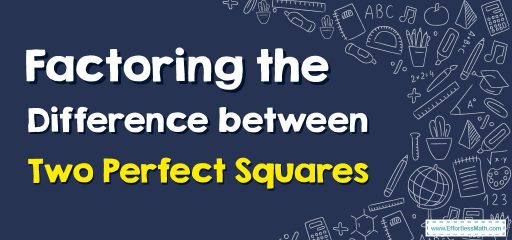How to Factor the Difference between Two Perfect Squares?
The technique of factoring the difference between two perfect squares is used when you want to factor a polynomial that involves the subtraction of two perfect squares. In this step-by-step guide, you will learn more about this technique!
[include_netrun_products_block from-products="product/6-south-carolina-sc-ready-grade-3-math-practice-tests/" product-list-class="bundle-products float-left" product-item-class="float-left" product-item-image-container-class="p-0 float-left" product-item-image-container-size="col-2" product-item-image-container-custom-style="" product-item-container-size="" product-item-add-to-cart-class="btn-accent btn-purchase-ajax" product-item-button-custom-url="{url}/?ajax-add-to-cart={id}" product-item-button-custom-url-if-not-salable="{productUrl} product-item-container-class="" product-item-element-order="image,title,purchase,price" product-item-title-size="" product-item-title-wrapper-size="col-10" product-item-title-tag="h3" product-item-title-class="mt-0" product-item-title-wrapper-class="float-left pr-0" product-item-price-size="" product-item-purchase-size="" product-item-purchase-wrapper-size="" product-item-price-wrapper-class="pr-0 float-left" product-item-price-wrapper-size="col-10" product-item-read-more-text="" product-item-add-to-cart-text="" product-item-add-to-cart-custom-attribute="title='Purchase this book with single click'" product-item-thumbnail-size="290-380" show-details="false" show-excerpt="false" paginate="false" lazy-load="true"]

A step-by-step guide to factoring the difference between two perfect squares
Factoring the difference between two squares is a special case of factoring a polynomial, where you factor a binomial, which is the difference between two terms that are both perfect squares.
Writing a binomial as the difference between two squares simply means that you rewrite a binomial as the product of two sets of parentheses. For example, \(a^2−b^2 =(a+b)(a−b)\). The binomial \(a^2−b^2\) can be factored into two sets of parentheses multiplied by each other. \((a+b)(a−b)\) will produce \(a^2−b^2\) when multiplied.
Not all terms can be factored in using this method. There are several clues to look for when determining whether an expression can be factored using the difference of squares. In the previous example, a2-b2, each term is a perfect square, and there is a subtraction symbol between each term. These are two useful clues to look for when determining whether a binomial can be factored using the difference between two squares. If these two clues exist, the expression can be factored using the difference of squares.
Factoring the Difference between Two Perfect Squares – Example 1:
Factor the following binomial using the difference of two squares method. \((x^2-81)\)
Solution:
The expression \((x^2-81)\) can be factored using the difference of two squares because both expressions are perfect squares and the expressions are separated by a subtraction sign. \(x^2\) is \(x\) times \(x\) and \(81\) is \(9\) times \(9\). \((x^2-81)\) can be rewritten as the product of \((x+9)(x-9)\).
Exercises for Factoring the Difference between Two Perfect Squares
Factor each polynomial using the difference of two squares method.
- \(\color{blue}{(64-x^2)}\)
- \(\color{blue}{(49x^2-25y^2)}\)
- \(\color{blue}{(625\:m^4-36y^2)}\)
- \(\color{blue}{(4x^4-144y^2)}\)
- \(\color{blue}{(8+x)(8-x)}\)
- \(\color{blue}{\left(7x+5y\right)\left(7x-5y\right)}\)
- \(\color{blue}{\left(25m^2+6y\right)\left(25m^2-6y\right)}\)
- \(\color{blue}{4\left(x^2+6y\right)\left(x^2-6y\right)}\)
Related to This Article
More math articles
- ACT Math: Test-Taking Strategies
- The Best HiSET Math Worksheets: FREE & Printable
- Do You Have to Pass the STAAR Test?
- A Deep Dive Into The World of Vector-Valued Function
- Full-Length 8th Grade FSA Math Practice Test
- Other Topics Puzzle – Challenge 94
- FTCE Test Facts and FAQs
- How to Differentiate Trigonometric Reciprocals
- 5th Grade RICAS Math Worksheets: FREE & Printable
- Top 10 Tips to Create an AFOQT Math Study Plan















What people say about "How to Factor the Difference between Two Perfect Squares? - Effortless Math: We Help Students Learn to LOVE Mathematics"?
No one replied yet.